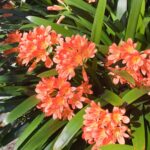Frost forms when conditions are very cold (around 0º C) and clear. On overcast nights temperatures are usually a little warmer (the cloud layer traps some of the day’s warmth) so frost is unlikely. Frost is formed when dew condenses overnight and freezes.
Frost will form on the ground and on plants.
Frost damages plants because the moisture inside the cells of the leaves, stems and shoots will freeze when temperatures fall. As with ice in the fridge, the water inside plants will expand as it freezes. A sudden melting of the frozen liquid will damage plant tissue. This rapid thaw is particularly likely in many parts of Australia where warm, sunny days often follow cold, frosty nights.
Frost damage on plants resembles burning. It usually affects the growing tips or exposed leaves. Frost damaged plant tissue may be brown or black.
The likelihood of frost in any area relates to features in the landscape such as the degree of slope or flatness or elements such as hedges, fences and buildings.
Cold air is heavier than warm air so it will flow down into valleys, pooling at the bottom. This is why frost is more likely in valleys than on high slopes. In a garden, cold air will roll along the ground, settling in a hollow.
An interruption to this natural flow, such as a fence or hedge across the slope, will cause cold air to pond behind the barrier making a particular area more frost prone.
To avoid creating frost traps leave a break in hedges and fences so cold air can flow through. Alternatively place fences down rather than across a slope as this will not impede the natural air flow.
Buildings or solid structures absorb heat during the day and radiate it at night. This will be enough to slightly raise the temperature for several metres, creating a frost-free zone around a building.
Tree cover will also reduce frost as the area underneath a tree will be sheltered from dew. The canopy of leaves or branches will slightly reduce heat loss at night so the area will not be as cold.
Evaluate your garden for areas that are likely to form frost and others that are likely to form frost and others which are likely to be warmer and frost free. These areas are referred to as microclimates. If you want to grow plants such as hibiscus or frangipani in a garden that may experience frost, choose the warmest part of your garden (for example around the house).
Cheating frost:
There are ways of reducing the likelihood of frost or minimizing the effect a frost will have it it strikes.
- A fine watering system turned on very early in the morning (before sunrise) will reduce the likelihood of frost damage or will gently melt ice that has formed. If you don’t have a watering system, gently hose frost-affected plants before the warmth of the sun can rapidly melt the ice. This gentle thawing should reduce cell damage
- Use frost protection products such as plastic sleeves or put newspaper or straw over annuals or vegetable seedlings at night.
- Move pot plants to a position under eaves of the house.
- Larger areas can be draped overnight with shade cloth (which should be removed the next morning).
- Some plants have adaptations which make them frost resistant – eg leaves that hang down such as with some species of rhododendrons; lower internal freezing points; toughened outer “skins” on leaves. Dormant plants are frost resistant until the dormant period breaks and new shoots form.
- If you have plants that are burnt by a frost, do not cut off damaged foliage until after the frosts have finished for the year. The damaged leaves will protect other tissue from further damage.
Frost Hardy Plants & plant groups:
Conifers; gingko, northern hemisphere deciduous trees such as oak, elm, maple, beech, crab apple, flowering cherries, pieris, rhododendrons, viburnum; English box, hostas, hellebores, peonies, many bulbs; heaths.
Australian native plants that are indigenous to frost prone areas will also be frost tolerant.
A murraya was shown that had effectively been topiarised by frost. The side of the plant facing east was hit by the sun and burned the outside of the plant as it warmed up the frozen leaves. In this way the plant was shaped by the frost.



